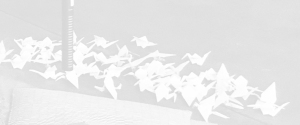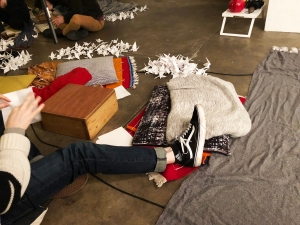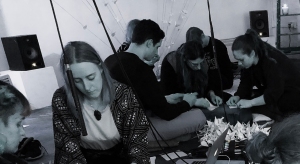 Nine people sitting on the basement floor folding paper into origami birds, four microphones hanging from the ceiling, a loudspeaker pair at each end of the room. A sound going on, unmistakeably but ambiguously emanating from this activity, suggestive of the palpitations of a locust swarm, the feeding of insect eaters biting their way through a bounty of desiccated wings and bleached bones. The white cranes accumulate, piling up in earthbound flocks next to their makers. I am conscious of furniture in the room, the chair on which I sit, the movement of hands, a thin garment hanging loosely on the wall, a vivid red teapot.
Nine people sitting on the basement floor folding paper into origami birds, four microphones hanging from the ceiling, a loudspeaker pair at each end of the room. A sound going on, unmistakeably but ambiguously emanating from this activity, suggestive of the palpitations of a locust swarm, the feeding of insect eaters biting their way through a bounty of desiccated wings and bleached bones. The white cranes accumulate, piling up in earthbound flocks next to their makers. I am conscious of furniture in the room, the chair on which I sit, the movement of hands, a thin garment hanging loosely on the wall, a vivid red teapot.
 Gradually, patterns emerge in the sound, lulls falling mysteriously, overtaken by industrious surges. A Max patch is at work. Now the sound piece thins, leaving a sparse acoustic crackle that exactly matches the quick, concentrated effort of the folders. Their number has grown to fourteen. This is a durational piece – four hours at this point – so some of them have returned from a break. The atmosphere of dedication is the focal point that holds it all within its shape and volition, no obvious breakage points other than the sight of doing and making, the growth of birds.
Gradually, patterns emerge in the sound, lulls falling mysteriously, overtaken by industrious surges. A Max patch is at work. Now the sound piece thins, leaving a sparse acoustic crackle that exactly matches the quick, concentrated effort of the folders. Their number has grown to fourteen. This is a durational piece – four hours at this point – so some of them have returned from a break. The atmosphere of dedication is the focal point that holds it all within its shape and volition, no obvious breakage points other than the sight of doing and making, the growth of birds.
Upstairs we speak in low voices, respectful of the crackling quiet below.
For a moment I think of Chim-Pom’s installation pieces – Non-Burnable, Real Thousand Cranes and The History of Human – all of which refer to the vast quantities of paper cranes sent from all over the world to the city of Hiroshima each year and to the practice of Senbazuru, folding one thousand paper cranes connected together by strings. According to Japanese legend, a person who folds one thousand paper cranes – one for every year of the mystical crane’s life – will be granted whatever they wish for.
But then I think of the sounds of labour: the physical impact of an axe cutting into a tree, the making of objects by hand, a typing pool (as seen only in old films) or the agricultural workers in Suffolk who would ease the monotony of threshing by mimicking the patterns of bell-ringing, their flails beating the same rhythm on the elm floor as the bells in a church steeple.
There are those records in my collection devoted only to songs and sounds of working: a Folkways 10-inch LP, The World of Man: His Work, which, notwithstanding the title, includes examples of women working: a Norwegian woman calling cattle to the barn to be milked, a Japanese woman spinning thread, women waulking, pounding and pulling tweed in the Hebrides, singing to make the work go with joy and pace. Then more grim than that, Alan Lomax’s recordings of prison songs made at Parchman State Penitentiary, Mississippi, in 1947, and Bruce Jackson’s Wake Up Dead Man: Black Convict Work Songs from Texas Prisons, made in 1965-6, the percussive thud of axes and hammers resounding in hot air as they rise and fall in unison, beating the rhythm of songs like “Rosie”, “Grizzly Bear” and “Early In the Morning.”
 Lucie Stepankova’s idea for Fold was to bring together a spatial composition with this physicality, the working of paper and legend, “[exploring] the sonority of the ancient tradition of paper folding (origami), its ritual aspects and meditative potential. It values collectivity, simplicity and the transcendental quality of repetition over a long duration.”
Lucie Stepankova’s idea for Fold was to bring together a spatial composition with this physicality, the working of paper and legend, “[exploring] the sonority of the ancient tradition of paper folding (origami), its ritual aspects and meditative potential. It values collectivity, simplicity and the transcendental quality of repetition over a long duration.”
At the beginning of Yasunari Kawabata’s post-war novel, Thousand Cranes, a young woman serves tea to the male protagonist. She becomes known as the girl of the thousand cranes, simply because she “carried a bundle wrapped in a kerchief, the thousand-crane pattern in white on a pink crape background.” The image of a thousand cranes haunts the text. Starting up in flight or flying across the evening sun, their flashes of brilliance momentarily cut across guilt and suffering. “The sound of her broom became the sound of a broom sweeping the contents from his skull, and her cloth polishing the veranda a cloth rubbing at his skull.” Happiness is a wish.
Fold, a listening environment, was performed at Hundred Years Gallery, E2 8JD, during the afternoon of Saturday March 24th, 2018.


You must be logged in to post a comment.